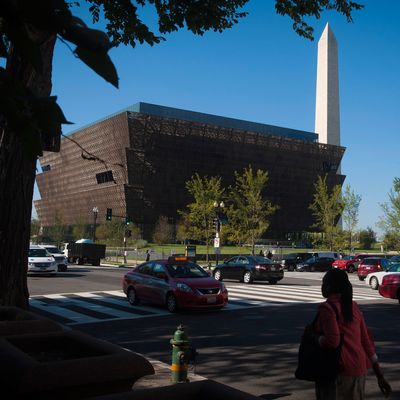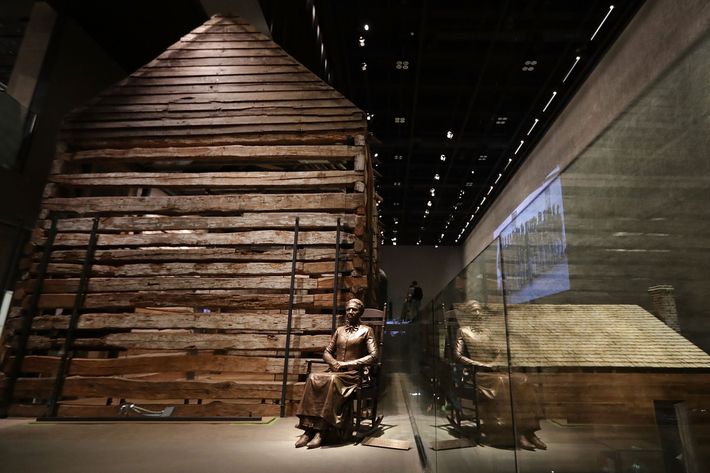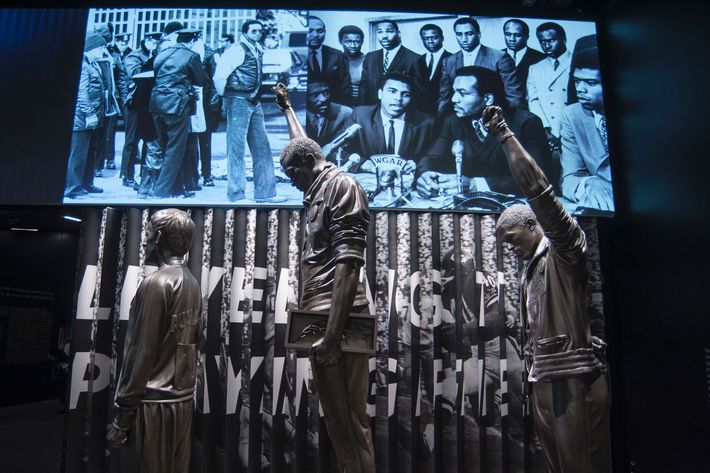
An indispensable new presence has risen on the National Mall, a showcase of glory and shame. Its dark bronzed skin broods in the glare of morning, glows in the late afternoon sun, and at all times contrasts with the marble-white uniformity of Washington’s official architecture. You could hardly ask for a more literal, or more effective, architectural assertion of a building’s mission. The National Museum of African American History and Culture, an institution full of purpose but badly in need of a nickname, blooms out of the capital’s central lawn in three expanding tiers. The shape echoes an urban-scaled version of the headdress on a Yoruba sculpture, advertising the African roots of American culture. A cantilevered canopy shades a porch vast enough to welcome a multifarious community — which is to say, all of us.
Architecture and identity rarely fuse as convincingly as they do here. Simple in form and intricate in execution, the museum performs an impossible job with grace, walking visitors through a linear tale and at the same time submerging them in the crosscurrents of black America. It educates and confuses, exalts and enrages, simplifies history and pummels visitors with hailstones of knowledge. At times a visit feels like wandering through a sprawling bibliography; each vitrine makes me want to read another book.

The building sits at the capital’s symbolic hinge, where the Mall meets President’s Park and the Washington Monument. Its narrative winds through and around the one told in the Smithsonian’s National Museum of American History and Culture across 14th Street. That institution long ago claimed the Woolworth counter from the 1960 Greensboro sit-ins, so its younger sister has to make do with a single stool. You can’t tell America’s story without also telling black America’s story. Our music sprang from the marriage of cotton-field work songs and European marches. Our notions of freedom were compromised by trying to justify oppression. Our ideals of including all comers depended on excluding many who were already here. American history consists of narratives and counter-narratives, each one cogent, sprawling, and incomplete, and to fully appreciate the relationship between them, you need both of these separate but complementary institutions.
The museum’s existence, decreed by President George W. Bush over the objections of some recalcitrant members of Congress, represents a triumph of tenacity and vision. Founding director Lonnie Bunch spurred the museum into being, scared up half a billion dollars, and accumulated 37,000 objects, only a tenth of which are currently on display. The Ghanaian-British David Adjaye led a design team that included two distinguished African-American architects, Phil Freelon and the late Max Bond. The result is a 400,000-square-foot building that can be clunkily obvious and underdetailed but also grand, alternately claustrophobic and vacant, triumphant and demoralizing.
Visitors enter a broad, open lobby that serves as the museum’s midpoint, both overture and interlude between the historical journey below and the celebratory galleries above. The first steps are easy: A twisting black staircase drops down to the theater and café. After that, though, you plunge farther underground, to the floor of an immense cellar walled with rough, dark concrete. The story of black America begins at the bottom of a swamp. From there, we follow a long march up a zigzagging ramp, from darkness to daylight, from the origins of the Atlantic slave trade to the Obama presidency. The architecture literalizes the metaphor of uplift, but that trajectory subsumes a lot of violence and backlash.

The new museum makes visible the case that Ta-Nehisi Coates argues with unflinching eloquence in Between the World and Me: that American prosperity is based on the exploitation of African-Americans, and that we all still enjoy the fruits of the misery inflicted on them. It’s not just the pair of rusted shackles that drive that lesson home, or the guard tower from the Angola prison, or Nat Turner’s bible, or the diagrams showing how slavers packed captive Africans in a ship’s hold for the four-month journey to the United States. It’s the sheer accumulation of facts and artifacts that give the story its texture.
All museums are by definition selective; every anthology rings with omissions, and this one gives everyone something to be indignant about. Still, as the exhibit clicks from topic to topic and decade to decade, it’s hard to avoid a feeling of studied neutrality and extreme compression. The often vituperative feud between Booker T. Washington and W.E.B. Dubois comes off as an exchange of bloodless theoretical abstractions. In short clips we see Stokely Carmichael as the clear-eyed firebrand, coolly furious in his rational dissection of history. We do not see the Carmichael who remarked: “I’ve never admired a white man, but the greatest of them, to my mind, was Hitler.” The exhibits include a slave driver’s bullwhip, but none of the Black Panthers’ guns. In a film clip near the end of the historical trajectory, the civil-rights legend Representative John Lewis proclaims the need for a museum that tells a people’s story plain and true, without avoiding its “hard edges.” And yet those edges have been neatly shaped and sanded to make them safe for public display.
On the day of the press preview, workers were still installing displays, but even when the museum finally opens to the public on September 24, it will feel at once monumental and provisional. The three-layered bloom of the building suggests that it could keep on rising toward a more brilliant future. (Washington’s height limits preclude that.) On the upper floors, broad, empty hallways encircle darkened galleries so stuffed with jangling exhibits they resemble a casino arcade. Some of the objects on display here haven’t quite made the transition from memorabilia to historical artifact (although I did get a charge from a close encounter with the P-Funk Mothership). Speakers bleed into each other’s acoustic space, so that Leontyne Price’s iridescent soprano beats against an early blues guitar. The show glides over the complexities of influence or the evolutions of genre, offering instead just a series of illustrated entries. It mutters about the African roots of African-American music, then skips away to the shiny, sexy stuff, like Chuck Berry’s Cadillac. I came away overstimulated and underinformed.
These faults can be tweaked as the museum evolves. The most seductive aspect of Adjaye’s design is also its most permanent: the building’s bronzed aluminum screen, a digital extrapolation of iron railings wrought by slaves. The pattern gets mirrored and flipped to form a four-quadrant panel, which repeats over the façade’s entire expanse. Despite that regularity, the filigree appears almost random from a distance, like a lattice of butterscotch swirls. That screen is a sly move, at once practical, beautiful, and emblematic of the veils that have obscured memory and made black Americans invisible to their fellow citizens. It textures the façade and shades the interior from glare, parting just enough for perfectly framed views of the Washington Monument. Standing on an indoor balcony, we look out at the capital campus through a clarifying scrim. Adjaye has reframed the nation’s preeminent icon as an object behind glass — an ambiguous symbol best comprehended in the context of black America’s story.






























